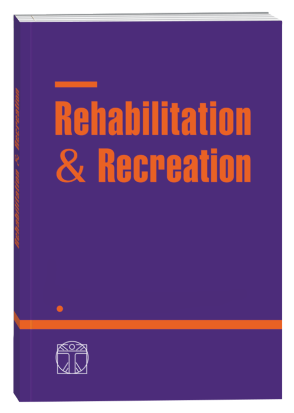PHYSICAL ACTIVITY AND FORMS OF MOTION EXERCISES IN PREGNANT WOMEN
DOI:
https://doi.org/10.32782/2522-1795.2023.15.26Keywords:
pregnancy, childbirth, puerperium, physical activity.Abstract
One of the main values is human life and health. According to the World Health Organization (WHO), health is a state of complete physical, mental and social well-being and not merely the absence of disease. Health-promoting behaviors include: healthy eating and physical activity. Pregnancy is a special period in a woman’s life. The main factor that has a huge impact on its course is the lifestyle of the expectant mother. Its important element is physical activity, bringing many positive benefits for the mother’s body, whose overload increases with the development of pregnancy. Pregnant women more and more often undertake physical activity, from which they derive multi-directional benefits without negative consequences for the health of the child. Regular exercise during pregnancy allows you to: maintain body fitness, prevent excessive weight gain, facilitate childbirth and shorten postpartum period. Before starting the exercises, it is necessary not only to consult a doctor, but also an instructor of physical activities to choose the right type of training, adjust the load to the development of pregnancy and the individual capabilities of the pregnant woman. Recently, the subject of physical activity has been appearing more and more often in combination with topics related to pregnancy and the health of a pregnant woman. In recent years, the percentage of women who engage in physical activity during pregnancy has increased significantly. In Poland, it is largely related to the change in the standard of perinatal care. Today’s mothers-to-be do not want to be like other "typical" women who lie down and, on the advice of their mothers or grandmothers, "eat for two", thus ignoring their ambitions and dreams of being a slim, active and stylish mother. More and more often, famous women in the field of business, entertainment or sport post their pregnant photos on the Internet while practicing various types of physical activity, as well as advice on a healthy and active lifestyle (training plans implemented by them, principles of eating habits, methods of reducing tension and stress). Systematic physical activity of moderate intensity performed by women during pregnancy and the postpartum period is safe and brings a number of benefits not only to the expectant mother, but also to her child.
References
Brega L., Grygus I. (2013). Stosowanie współczesnych technologii przedporodowej korekcji przy nieprawidłowych i miednicowych położeniach płodu. Pop T. (red.). T. 1. Wartość rehabilitacji w świadomości współczesnego człowieka. Wydawnictwo Uniwersytetu Rzeszowskiego, Rzeszów. 19-27.
Brzozowska E. (2013). Sport wyczynowy a ciąża. Magazyn Trenera, nr 27.
Chitryniewicz-Rostek J., Kulis A., Kreska-Korus A. (2015). Wpływ aktywności fizycznej na stan psychofizyczny kobiet w ciąży. Rehabilitacja Medyczna, nr 19.
Dębski S.S., Skalski D., Lizakowski P., Grygus I., Stanula A. (2017). Zdrowotne właściwości zachowań ruchowych – wybrane zagadnienia. Medycyna i zdrowie. 2:12-44.
Drabik J. (2011). Profilaktyka zdrowia – aktywność fizyczna czy aktywność ruchowa. Wychowanie fizyczne i zdrowotne, nr 5.
Fraś M., Gniadek A., Poznańska- Skrzypiec J., Kadłubowska M. (2012). Styl życia kobiet w ciąży. Hygeia Public Health, nr 47.
Fuerest N., Adamczewska A. (2017). Znaczenie aktywności fizycznej i zalecane formy ćwiczeń ruchowych u kobiet w ciąży. Częstochowa. T. XVI, nr 3.
Grygus I., Jewtuch M. (2013). Wpływ zaproponowanej metodyki wychowania fizycznego na stan funkcjonalny studentów. Journal of Health Sciences. 3(9), 417-426.
Grygus I., Kucher T. (2013). Optymalizacja sprawności fizycznej studentów z różnymi rodzajami autonomicznego układu nerwowego. Journal of Health Sciences. 3(10). 583–604.
Grygus I., Kuczer T. (2013). Optymalizacja poziomu fizycznego zdrowia studentów z uwzględnieniem typu autonomicznego nerwowego systemu. Journal of Health Sciences. 3(6). 323–332.
Grygus I., Mykhaylova N. (2013). Wpływ ruchowej aktywności na stan zdrowia studentów. Journal of Health Sciences. 3 (5): 649-656.
Grygus I., Petruk L. (2015). Assessment of indices of physical development and functional status of female students of a special medical group. Journal of Education, Health and Sport. 5(10):158-169.
Grygus I., Kucher T. (2013). Optimizing the level of the physical health of the students with a glance of the type of autonomic nervous system. Physical Education of Students, 17(3), 26-30.
Krahel M., Krajewska- Kułak E., Okurowska-Zawada B. (2017). Aktywność fizyczna w ciąży – wybrane aspekty.
Parchomej I.M., Grygus I.M. (2017). Physical rehabilitation of pregnant women with obesity. Section 9. Medicine. Proceedings of V International scientific conference “Science of the third millennium”. Morrisville, Lulu Press. 186-189.
Popławska K. (2012). Kobieta w ciąży – coraz częstszy klient w klubie fitness. Trainer, nr 1.
Sass A., Mączka M. (2017). Physical activity of pregnant women in the light of scientific research – a review of the literature. Journal of Education, Health and Sport, nr 7.
Starczyńska M., Karwacińska J., Stepanek- Finda B., Kiebzak W. (2011). Historyczne podstawy fizjoterapii. Studia Medyczne, nr 21.
Szukiewicz D., Truszczyńska A. (2012). Fizjoterapia w ginekologii i położnictwie. Wydawnictwo Lekarskie PZWL, Warszawa.
Wytyczne UE dotyczące aktywności fizycznej. Czwarty projekt skonsolidowany. Zatwierdzony przez Grupę Roboczą UE „Sport i Zdrowie” na zebraniu w dniu 25 września 2008 r.
Downloads
Published
How to Cite
Issue
Section
License

This work is licensed under a Creative Commons Attribution-NonCommercial-NoDerivatives 4.0 International License.











